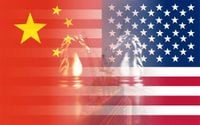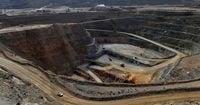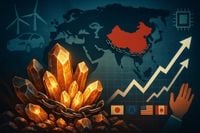China’s grip on the global supply of rare earth elements has tightened once again, sending shockwaves through international markets and prompting a scramble among nations and industries dependent on these critical minerals. On October 9, 2025, Beijing unveiled sweeping new restrictions on the export of rare-earth extraction technologies and materials, a move that comes just weeks ahead of a highly anticipated meeting between U.S. President Donald Trump and Chinese leader Xi Jinping at the APEC summit in South Korea. The timing, just two days before the expiration of the current U.S.-China trade truce, is no coincidence, signaling China’s intent to use its dominance in the sector as strategic leverage in ongoing geopolitical rivalries.
According to Aerospace Daily & Defense Report, the newly announced rules directly target rare earths essential for Pentagon supply chains and advanced technology sectors. The Chinese Commerce Ministry’s updated measures now require overseas producers to obtain export licenses for access to China’s extraction technologies and separation equipment. The restrictions also extend to synthetic diamond powders, single crystals, diamond wire saws, and related equipment, as well as lithium-battery components and artificial graphite materials. Exporters must now identify dual-use items and provide detailed technical parameters if their products approach control thresholds, a move that further complicates international procurement.
China’s latest clampdown is not limited to raw materials. As outlined by Asia Times, the new regulations also ban exports of certain middle and heavy rare-earth metals, alloys, oxides, and compounds, and establish licensing systems for rare-earth separation and extraction technologies. The unified measures will take effect on November 8, 2025, underscoring Beijing’s resolve to protect its technological edge and resource security. Four related documents released by China’s Commerce Ministry and Customs detail the sweeping nature of these controls, which now also encompass intellectual property and prohibit unauthorized overseas mining activities by Chinese citizens.
The expanded controls arrive on the heels of a major development: on September 8, Pakistan signed a memorandum of understanding with U.S. Strategic Metals to produce critical minerals in Pakistan. The South Asian country, long described by Chinese media as China’s “iron brother,” holds an estimated five million metric tons of rare earth reserves worth several trillion dollars. In a sign of shifting alliances, Pakistan has already shipped its first batch of rare earth elements to the United States, a move that has not gone unnoticed in Beijing. As a Shandong-based columnist put it in Asia Times, “Pakistan’s five million metric tons of rare earths reserves, worth several trillion dollars, have suddenly become a new focal point in the strategic rivalry between China and the US.”
This rivalry is not just about rocks and minerals—it’s about who controls the future of technology and defense. China currently accounts for more than 60% of global rare earth production, about 70% of lithium refining, nearly 70% of cobalt processing, and over 90% of battery-grade graphite output, according to Asia Times and Market Minute. Its dominance is the result of decades of state investment, technological advancement, and a national strategy focused on resource and industrial security. The nation’s rare-earth extraction methods, mainly solvent extraction and ion exchange, are the product of years of scientific innovation, including breakthroughs by chemist Xu Guangxian, who separated praseodymium and neodymium in the 1970s—a feat that underpins China’s near-monopoly in high-performance neodymium magnet production today.
The ripple effects of China’s announcement were immediate and dramatic. As reported by Market Minute, shares of non-Chinese mining companies surged—MP Materials, operator of the only integrated rare earth mine and processing facility of scale in the United States, saw its stock jump over 6%. Other American mining firms, including Lithium Americas and Trilogy Metals, also experienced significant gains. Meanwhile, Chinese domestic rare earth giants such as China Northern Rare Earth Group and Shenghe Resources saw their shares spike by up to 10%, reflecting investor confidence in their strengthened market position.
But it’s not all good news. For companies and countries heavily reliant on Chinese rare earth imports—especially those in advanced manufacturing, defense, clean energy, and electronics—the new rules spell trouble. Higher material costs, increased supply chain complexity, and the urgent need to secure alternative sources are now front and center. The United States, for instance, operates only one rare earth mine, making it particularly vulnerable to supply shocks. Policymakers are responding by ramping up investments in domestic mining projects and forging new international partnerships, as reported by Market Minute and Asia Times.
“American defense contractors urgently need these rare earths to sustain production of F‑35 fighter jets and nuclear submarines. Meanwhile, China, with 92% of the world’s rare-earth refining capacity, retains control of the key extraction and purification technologies,” noted a columnist cited by Asia Times. The real value, he argued, lies in the separation technologies, since 90% of the 250 rare-earth minerals discovered globally occur in mixed form. “The extraction and purification of rare earths is like picking black beans from a bowl of sesame,” he explained. Even with new mining projects outside China, achieving military-grade purity without Chinese know-how remains a formidable challenge.
Market volatility has become the new normal. The VanEck Rare Earth and Strategic Metals ETF soared 91% in 2025, and shares of US and Canadian producers spiked by up to 18% at their peak, according to Market Minute. Yet, as earlier in the year showed, the rare earth market is acutely sensitive to policy changes and perceived shifts in supply. When China increased rare earth exports in July, some US companies saw their stocks tumble, underscoring just how delicate and reactive the sector has become.
The broader implications are profound. As Market Minute and Asia Times both point out, the global race for critical minerals is now a defining feature of international trade and security policy. The European Commission has already flagged concerns and is actively studying the new controls, signaling that further diplomatic and trade responses may be on the horizon. This episode echoes past instances of resource weaponization—think oil embargoes or strategic metals during wartime—but with a modern twist: the ubiquity of rare earths in everything from smartphones and electric vehicles to wind turbines and advanced defense systems.
Looking ahead, nations are expected to double down on efforts to build resilient, independent rare earth supply chains. This will likely involve significant investments in mining, refining, and recycling technologies outside China, as well as the development of rare earth-free alternatives. Policy responses could include subsidies, tax incentives, and streamlined permitting for mining projects. The stakes are high: whoever controls the flow of rare earths controls the future of technology, green energy, and defense.
China’s assertive moves have set the stage for a new era—one where strategic mineral autonomy is no longer a choice, but a necessity. The world is watching, and the race for rare earth independence has only just begun.



